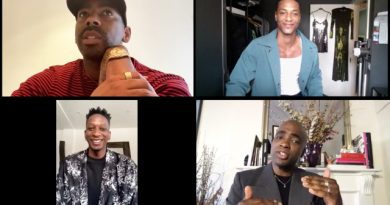Is L.A. becoming the new beauty capital of the world?
This week, I head for L.A. (at least mentally) and check in on Twitter Spaces.
Last Wednesday, L’Oréal, the No. 1 cosmetics company in the world, announced its second company headquarters for L’Oréal USA in El Segundo, California outside of Los Angeles. The 100,000-square-foot indoor and outdoor office space is expected to open in early 2022, and will be the home of the company’s first West Coast L’Oréal Professional Products Academy. With the move, the company’s California brands, NYX Professional Makeup, Urban Decay and Pulp Riot, will receive unprecedented new attention. The announcement obviously gives L’Oréal USA more access to celebrities, influencers and cultural events in L.A. and California. But beyond the internal ramifications, it underscores L.A.’s growing importance to the global beauty market.
“As the worldwide beauty leader and the USA leader, to be the first company to set foot in this very important region of the United States [with a headquarters] shows the commitments that we have to a consumer ecosystem — to trends, to new behaviors, to new innovation and that great creativity that’s coming from California,” Stephane Rinderknech, president and CEO of L’Oréal USA, told me over a video call last week.
The beauty customer is certainly there. According to Rakuten Intelligence, of the 116 million people that made beauty purchases online during the pandemic, 6.3 million were from Los Angeles, Riverside and Orange counties, up 27% compared to 2019. Local shoppers also spent 32% more than in 2019, hitting $917 million in 2020.
The importance of celebrity culture is likely one of the biggest considerations for the larger beauty market, as it appears that every actor, influencer and musician hopes to follow in the footsteps of Kylie Jenner and Kim Kardashian. The same goes for the wellness category, as Gwyneth Paltrow’s Goop continues to be the gold standard. And Jessica Alba’s The Honest Company, which recently filed for a $100 million IPO, proves the long-term power of celebrity scale. With new beauty and wellness founders being minted daily — think Addison Rae, co-founder of Item Beauty — it’s smart business for conglomerates and beauty brand incubators to have a more substantial presence in the area.
“L.A. is the hub of creatives. If you are a creative, you tend to flock to Los Angeles, and you’re seeing that more with the TikTok group now,” said Ben Jones, Haus Laboratories CEO. Before joining Lady Gaga’s beauty brand in 2018, Jones was chief digital officer at Alba’s The Honest Company.
New Haus Laboratories CMO Kelly Coller added that traditional talent like actresses and musicians also want more skin in the brands they create. “Licensing was the original way to come to market, but founders and creators at large started to change that about 10 years ago. They have a unique point of view and want to own that,” she said. Lady Gaga is living proof of that, as Jones said that her music, acting and beauty ventures are the three businesses that she owns outright. Lady Gaga, of course, is based in Los Angeles.
While L.A. is certainly the celebrity capital of the world, Rinderknech acknowledged the area’s proximity to technology, found west of Manhattan Beach in Silicon Beach, is an advantage. It’s also close to like-minded brands and corporate talent. “There’s a huge ecosystem of brands — a media-tech corridor that we need to benefit from. Every day there is a new reason to justify this move,” he said.
Jones added that investors in the area are increasingly becoming more interested in beauty and wellness, calling out Haus Laboratories’ VC firm Lightspeed Venture Partners. “Silicon Valley is right there, and that is the capital of venture capital. They are starting to see what a great business beauty is,” he said.
Katie Welch, CMO of Selena Gomez’s Rare Beauty, said that L.A.’s closeness to other industries is imperative since the beauty industry is not as insular as it once was. Gomez is also based in the Los Angeles area. “There’s outstanding talent from entertainment, technology, music and media, who think outside traditional tactics,” she said. “We are inspired by dynamic new marketing approaches; t helps us think differently about our approach to brand building. At a time when marketing changes on an almost daily basis, it’s incredibly beneficial.”
Speaking of that ecosystem and talent, Guthy-Renker (El Segundo), Markwins Beauty Brands (Industry City), Beautycounter (L.A. County), Anastasia Beverly Hills (L.A. County) and Katherine Power’s Versed and Merit (West Hollywood) are all in the L.A. area, among others. Other influential retailers and brands found in San Francisco are not far, like Sephora and Beauty for All Industries (Ipsy and Boxy Charm’s parent company).
According to Cosmetic Executive Women [CEW], California is the second-largest state for members after New York, with the vast majority of CEW alumni in the Los Angeles area. Leslie Hutchings, CEW vp of membership and strategy, said L.A. is “a city of growth for membership.” Coller expects that to continue, with the cost of living in the Los Angeles area more palatable than New York or San Francisco, and more companies implementing a remote work schedule. In August 2020, L’Oréal USA announced a permanent hybrid work model, allowing eligible employees to work 40% of their time, or two days per week, remotely each week.
Neither the Los Angeles County Economic Development Corporation nor the Los Angeles Chamber of Commerce has broken out beauty and wellness as a substantial sector yet. But the city of Los Angeles was expected to have at least 1% employment growth annually between 2016 and 2021.
Jones expects more conglomerates to stake their claim in the area. “L’Oréal, Unilever, and Procter and Gamble have infrastructure and abilities that are amazing, but startups raise the bar for all,” he said. “The West Coast is the startup capital of the world.”
He added that an LA footprint will be strategic for acquirers as well. “Companies like L’Oréal are becoming more sophisticated at integrating companies. After they’ve acquired brands, you might see founders and talent leave. I think the big companies have tried to study ‘why.’ What they’ve learned over time is they have to let those people flourish with their own independence and creativity,” he said. ”
Rinderknech emphasized that he will be spending a good share of time in El Segundo and that the new headquarters will also give L’Oréal USA a better understanding of the diversity of the U.S. “My job is to be close to consumers and to be to be close to employees and talents, and understand how we all together become richer by infusing ourselves with different points of view, culture and diversity, from all the employees from all over the U.S.,” he said.
Twitter Spaces goes global
After a short beta period, Twitter Spaces launched worldwide on Monday afternoon. Accounts with 600 or more followers on Twitter will automatically have the audio feature enabled. In the coming months, “Ticketed Spaces,” where hosts can sell tickets to discussions will be available, as will co-hosting, scheduling and reminder abilities. Thus far, the beauty world has been enamored by Clubhouse, but Twitter said in its latest Beauty Report that #BeautyTwitter saw over 118 million Tweets in 2020. Fifty-four percent of those conversations are being driven by Gen Z. Stay tuned next week for my deep dive on beauty’s audio opportunity.
Reading List
Inside our coverage
Here are the Gen Z names shaping beauty.
More “cool” menopausal brands are coming to market.
Avon Company sets livestream ambitions.
Aveda updates its loyalty program.
Inside how Snif captivates young shoppers.
What we’re reading
Cheugy is the Gen-Z TikTok term for for millennial, girl boss energy.
Shiseido reportedly wants to sell its North American makeup assets, BareMinerals, Buxom and Laura Mercier.
Valentino is launching makeup.
And tennis star Naomi Osaka is launching skin care.



